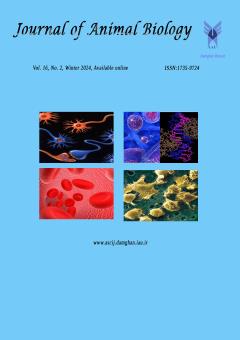Effect of Zataria multiflora Boiss. Extract against Carbon Tetrachloride – induced Liver Damage in Adult Male Wistar rats
Subject Areas : Journal of Animal BiologyZahra Taherkhani 1 , Akram Eidi 2 * , Pejman Mortazavi 3
1 - Department of Biology, Science and Research Branch, Islamic Azad University, Tehran, Iran
2 - Department of Biology, Science and Research Branch, Islamic Azad University, Tehran, Iran
3 - Department of Veterinary, Science and Research Branch, Islamic Azad University, Tehran, Iran
Keywords: Thyme, Zataria multiflora Boiss, Liver, Carbon tetrachloride, Rat.,
Abstract :
Thyme (Zataria Multiflora Boiss), belonging to the family Labiatae, is native to Iran and is used traditionally in food, especially in yogurt flavoring, as a stimulant, seasoning, and carminative. Very high medicinal properties of this plant were reported, such as antioxidant, antimicrobial, analgesic, and anti-inflammatory activity. This research aimed to evaluate the protective effects of ethanolic extract of thyme against hepatic damage induced by carbon tetrachloride (CCl4) in adult male Wistar rats. 40 rats were randomly divided into 8 groups: group 1 as normal control, groups 2-4 only thyme extract (50, 100, 200 mg/kg, gavage), group 5 (liver damage) receiving CCl4 (5/ 0 ml/kg, intraperitoneally, twice a week) for 8 weeks and groups of 6 to 8 thyme extracts (50, 100, 200 mg/kg, gavage) together with CCl4 (0.5 ml/kg, intraperitoneally, twice a week). At the end of the experiment (28 days), serum sample were prepared and the liver was removed for enzyme tests. CCl4 alone increased the serum levels of ALT, AST and ALP. Also, CCl4 treatment significantly decreased the levels of the antioxidant enzyme superoxide dismutase (SOD) activity and increased malondialdehyde (MDA) levels in the liver. Thyme extract treatment significantly improved the above parameters. Therefore, the results showed that thyme extract is a potent antioxidant agent against CCl4-induced liver damage in rats.
1. Ahmadipour A., Sharififar F., Nakhaipour F., Samanian M., Karami-Mohajeri S. 2015. Hepatoprotective effect of Zataria Multiflora Boiss on cisplatin-induced oxidative stress in male rat. Journal of Medicine and Life, 8:275-281.
2. Apostolova N., Blas-Garcia A., Esplugues J.V. 2011. Mitochondria sentencing about cellular life and death: a matter of oxidative stress. Current Pharmaceutical Design, 17(36):4047-4060.
3. Arab Z., Hosseini M., Marefati N., Beheshti F., Anaeigoudari A., Sadeghnia H.R. 2022. Neuroprotective and memory enhancing effects of Zataria multiflora in lipopolysaccharide-treated rats. Veterinary Research Forum, 13(1):101-110.
4. Attia Y.A.., Bakhashwain A.A., Bertu N.K. 2017. Thyme oil (Thyme vulgaris L.) as a natural growth promoter for broiler chickens reared under hot climate. Italian Journal of Animal Science, 16:275-282.
5. Attia Y.A., Bakhashwain A.A., Bertu N.K. 2018. Utilisation of thyme powder (Thyme vulgaris L.) as a growth promoter alternative to antibiotics for broiler chickens raised in a hot climate. European Poultry Science, 82:238-243.
6. Ayala A., Muñoz M.F., Argüelles S. 2014. Lipid peroxidation: production, metabolism, and signaling mechanisms of malon dialdehyde and 4-hydroxy-2-nonenal. Oxidative Medicine and Cellular Longevity, 2014(6):360438.
7. Castagliuolo I., Brun P., Busiello I., Miraglia N., Gnosis SpA. 2017. Formulations containing Saccharomyces boulardii and superoxide dismutase (SOD) to control obesity. U.S. Patent 9,555,082.
8. Fatemi F., Asri Y., Rasooli I., Alipoor S.D., Shaterloo M. 2012. Chemical composition and antioxidant properties of γ-irradiated Iranian Zataria multiflora extracts. Pharmaceutical Biology, 50(2):232-238.
9. Gholami-Ahangaran M, Ahmadi-Dastgerdi A, Azizi S, Basiratpour A, Zokaei M., Derakhshan M. 2022. Thymol and carvacrol supplementation in poultry health and performance. Veterinary Medicine and Science, 8(1):267-288.
10. Khajavi R.A., Mohebbati R. 2018. Zataria multiflora extract and carvacrol affect cardiotoxicity induced by Adriamycin in rat. Journal of Basic Clinical Physiology and Pharmacology, 30(1):73-79.
11. Lee S., Won K.Y., Joo S. 2020. Protective effect of poly deoxy ribonucleotide against CCl4-induced acute liver injury in mice. International Neurology Journal, 24(Suppl 2):88-95.
12. Masuda Y Yakugaku Z. 2006. Learning toxicology from carbon tetrachloride-induced hepatotoxicity. Yakugaku Zasshi. 126(10):885-899. [In Japanese].
13. Mohebbati R., Paseban M., Beheshti F., Soukhtanloo M., Shafei M.N., Rakhshandeh H. 2018. The Preventive effects of standardized extract of Zataria multiflora and carvacrol on acetaminophen-induced hepatotoxicity in rat. Journal of Pharmacopuncture, 21(4):249-257.
14. Muriel P., Rivera-Espinoza Y. 2008. Beneficial drugs for liver diseases. Journal of Applied Toxicology, 28(2):93-103.
15. Nobakht M., Darmani-kuhi H., Mohiti-Asli M. 2017. Effect of Zataria multiflora boiss (thyme) extract and fat on meat quality, intestinal pH and serum antioxidant status of broiler chicks. Animal Production Research Anim Prod Res, 6:51-61.
16. Pan Y., Long X., Yi R., Zhao X. 2018. Polyphenols in liubao tea can prevent CCl₄-induced hepatic damage in mice through its antioxidant capacities. Nutrients, 10(9):1280-1291.
17. Sahreen S., Khan M.R., Khan R.A. 2011. Hepatoprotective effects of methanol extract of Carissa opaca leaves on CCl4-induced damage in rat. BMC Complementary Alternative Medicine, 11:48-57.
18. Shomali T., Mosleh N. 2019. Zataria multiflora, broiler health and performance: a review. Iranian Journal of Veterinary Research, 20(2):81-88.
19. Singh N., Kamath V., Narasimhamurthy K., Rajini P.S. 2008. Protective effect of potato peel extract against carbon tetrachloride-induced liver injury in rats. Environmental Toxicology and Pharmacology, 26(2):241-246.
20. Sreelatha S., Padma P.R. 2009. Antioxidant activity and total phenolic content of Moringa oleifera leaves in two stages of maturity. Plant Foods and Human Nutrition, 64:303-311.
21. Srivastava A., Shivanandappa T. 2010. Hepatoprotective effect of the root extract of Decalepis hamiltonii against carbon tetrachloride-induced oxidative stress in rats. Food Chemistry, 118:411-417.
22. Trefts E., Gannon M., Wasserman D.H. 2017. The liver. Current Biology, 27(21):R1147-R1151.
23. Unsal V., Cicek M., Sabancilar İ. 2020. Toxicity of carbon tetrachloride, free radicals and role of antioxidants. Reviews on Environmental Health, 36(2):279-295.
24. Wang K., Sui D.J., Wang C.S., Yang L., Ouyang Z., Chen N.F. 2017. Protective effects of five different types of Dendrobium on CCl4-induced liver injury in mice. Zhongguo Zhong Yao Za Zhi. 42(10):1945-1950. [In Chinese].
25. Zhang C., Zhao J., Famous E., Pan S., Peng X., Tian J. 2021. Antioxidant, hepatoprotective and antifungal activities of black pepper (Piper nigrum L.) essential oil. Food Chemistry, 346:128845.

